![]()
![]()
![]()
Use LEFT and RIGHT arrow keys to navigate between flashcards;
Use UP and DOWN arrow keys to flip the card;
H to show hint;
A reads text to speech;
107 Cards in this Set
- Front
- Back
|
3 components of plant cells
|
1. Cell walls
2. Vacuoles 3. Chloroplasts |
|
|
Plasma Membrane
|
A selectively permeable barrier that regulates the movement of substances in and out of the cell.
|
|
|
Characteristics of a Cell Wall
|
1. Made mostly of cellulose
2. Function: support and protect 3. Flexible primary cell wall is present in all plants 4. Some cells have a rigid secondary cell wall imbedded with lignin |
|
|
Chloroplast
|
Specialized plastid where photosynthesis occurs.
|
|
|
Levels of Organization in Life
|
1. Atoms
2. Molecules 3. Cells 4. Tissues 5. Organs 6. Organisms 7. Ecosystems |
|
|
Vacuole
|
Membrane enclosed fluid filled space that can occupy up to 90% of a mature cell.
|
|
|
Functions of Vacuole
|
1. Helps maintain cell pressure
2. Storage and breakdown of cellular waste products. 3. Location of water soluble dyes called anthocyanins (purple and red in color) |
|
|
Parts of a Plant
|
Leaf
Node Internode Stem Root |
|
|
The Three Tissue Systems
|
1. Surface (dermal) Tissue
2. Vascular Tissue 3. Ground Tissue |
|
|
Epidermis
|
Outermost layer of cells covered with a waxy cuticle layer to prevent water loss. This is made up of more than one cell type.
|
|
|
Trichomes
|
Hairs on the epidermis "leaf hairs"
|
|
|
Stomata
|
Made up of guard cells that form pores to allow for the exchange of CO2 coming in and O and H2O coming out.
|
|
|
Ground Tissues
|
Present in most organs of the plant. Made of parenchyma and sclerenchyma cells, among other types.
|
|
|
Parenchyma Cells
|
Thin primary cell walls that can take on many shapes. They are living at maturity and contain a large central vacuole.
|
|
|
Function of Parenchyma Cells in Photosynthesis
|
Storage and transport food and water.
|
|
|
Sclerenchyma Cells
|
Dead at maturity, thick and rigid secondary cell walls that support and protect.
|
|
|
Two types of Sclerenchyma Cells
|
Sclereids (if short) and fibers (if long).
|
|
|
Vascular Tissue
|
Continuous tissue throughout the plant in which substances are transported.
|
|
|
Two types of Vascular Tissue
|
Xylem and phloem
|
|
|
Xylem
|
Vascular tissue that transports water and mineral salts.
Two types of cells" Tracheids and Vessel Elements |
|
|
Phloem
|
Transports sugars and other organic substances.
Consists of sieve tube members (the conducting cells). Sieve tubs members function with the help of Companion cells. |
|
|
Meristem
|
Where growth occurs
|
|
|
Primary Growth
|
Apical meristems: Primary tissues, increase in length
|
|
|
Secondary Growth
|
Lateral meristems: secondary tissues, increase in girth
|
|
|
Vascular Bundle
|
Bundle of Xylem and Phloem.
|
|
|
Wood
|
Secondary Xylem
|
|
|
Vascular Cambium in Monocots?
|
No vc in monocots because they do not become woody. Vc only in dicots.
|
|
|
Which is more abundant: Xylem or Phloem?
|
There is always more Xylem then Phloem being produced by the Vascular Cambium. The primary Xylem is always in the middle.
|
|
|
Early wood vs Late wood
|
Early wood is lighter and generally thicker because it grows during the wet season. Late wood is darker and generally smaller because it takes place in the dry season.
|
|
|
Heartwood
|
The middle of the tree that no longer transports water. Can be removed without harming the tree.
|
|
|
Sapwood
|
Unlike heartwood, sapwood still transports water and if removed could harm the tree.
|
|
|
When looking at a tree ring, the order of elements from inside to outside.
|
1. Primary Xylem
2. Secondary Xylem 3. Heartwood (dark) 4. Sapwood (light) 5. Vascular Cambium 6. Living Phloem 7. Periderm 8. Cork Cambium 9. Cork |
|
|
Look of a monocot vs dicot
|
Monocot's vascular bundles are random and unorderly.
Dicot's vascular bundles are radial and connected by the vascular cambium. |
|
|
Cork
|
Produced by the cork cambium, which develops from parenchyma cells in the cortex.
Replaces the epidermis. Protective outer coating. Cork cells are dead and impregnated with suberin wax. |
|
|
Lenticel
|
Tear in the bark that allows for gas exchange. Especially visible in light colored bark trees such as the Birch.
|
|
|
Stolons or Runners
|
Horizontal oriented stems.
Function: Vegetative Reproduction |
|
|
Succulent Stems
|
Spherical Stems
Low surface area-to-volume ratio Function: water storage |
|
|
Tuber Stems
|
The swollen end of an underground stem.
Function: Nutrient storage. |
|
|
California Statistics
|
200 miles wide
800 miles long N-S trending mountains Large central valley Large dessert areas |
|
|
California Topography
|
Has the highest and lowest points in US: Mount Whitney (14,495 ft) & Death Valley (276 ft below sea level).
|
|
|
Mediterranean Climate
|
Mild, wet winters and warm, dry summers. Only 2% of world has this climate, including portions of CA such as SLO.
|
|
|
Further from the coast...
|
...The more significant the changes are in the seasons and in daily temperatures.
|
|
|
Influence of Topography and Elevation
|
Precipitation increases and temperature decreases with elevation due to the orographic effect.
|
|
|
Rain Shadows
|
Created by mountains, the climate is drier on lee slopes of mountains than on windward slopes.
|
|
|
Plant Community
|
An assemblage of populations living in the same area.
|
|
|
Functions of Roots
|
1. Anchorage
2. Absorption 3. Conduction 4. Storage |
|
|
2 kinds of root systems
|
1. Taproot
2. Fibrous root: adventitious roots (no one root is dominant) |
|
|
Taproot
|
Has one main root that grows downward.
Ex. Pine trees, carrots, and beets. |
|
|
Fibrous Root
|
Has many adventitious roots. No one root is more prominent then the others.
Ex. Wheat and corn |
|
|
Root Cap
|
Covers the tip of the root. Helps guide the roots through the soil and protects the meristem.
|
|
|
Mucigel
|
A polysaccharide coating that lubricates the soil ahead of the growing root. Produced by the root cap.
|
|
|
3 Zones of Cells in Roots
|
1. Zone of Cell Division
2. Zone of Cell Elongation 3. Zone of Maturation (differentiation) |
|
|
Zone of Cell Division
|
Located near the tip of the root, includes the apical meristem and its derivatives.
|
|
|
Zone of Cell Elongation
|
Zone where cells enlarge and elongate up to 100 times their original length. This process pushes the root tip through the soil.
|
|
|
Zone of Maturation
|
Region where the new cells become specialized in structure and function. Region where epidermal root hairs form.
|
|
|
Epidermis in Roots
|
Provides protection, absorbs water and minerals from the soil.
|
|
|
Vasculature in Roots
|
Central column of xylem with radiating arms, alternating with strands of phloem.
|
|
|
Pericycle
|
Outer boundary of vascular tissue, gives rise to lateral roots.
|
|
|
Lateral Roots
|
Pushes through the cortex until emerging from the primary root. Stays connected to vascular tissue for water and nutrition.
|
|
|
Dicot Vasculature
|
Vascular bundle where xylem forms and X in the middle, surrounded by phloem. Pericycle and endodermis form a ring around bundle, all surrounded by the cortex.
|
|
|
Cortex in Roots
|
Occupies the greatest volume of the primary body of most roots. Major function: storage of starch.
|
|
|
Amyloplast
|
An organelle that contains large starch grains.
|
|
|
Endodermis of Roots
|
Tightly packed innermost ring of cells i the cortex. Each cell is surrounded by a Casparian strip impregnated with suberin and lignin.
|
|
|
Caparian Strip
|
A band of wall material in the endodermis containing suberin and lignin. Function: regulate what enters and leaves the vascular cylinder.
|
|
|
Aerial Roots
|
Roots that grow above ground. Usually found in humid environments.
|
|
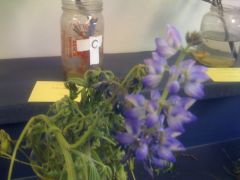
|
Lupine
Lupinus spp. |
|
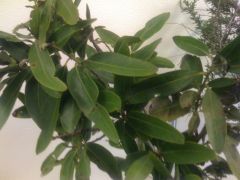
|
California Bay-Laurel
Umbellularia Californica Oak Woodlands and Riparian Areas |
|
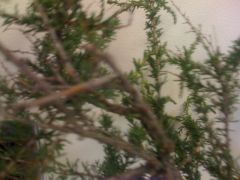
|
Chamise
Adenostoma Fosiculatum Chaparral |
|

|
Italian Ryegrass
Lolium Multiflorum Grassland |
|
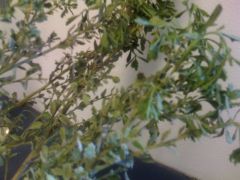
|
Coyote Brush
Baccharis Pillularis Coastal Shrub |
|
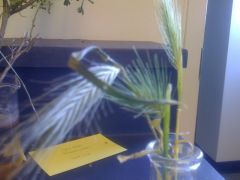
|
Foxtail Barley
Hordeum Murinum Grassland |
|
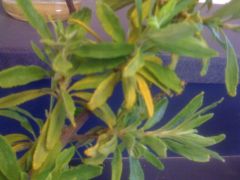
|
Black Sage
Salvia Mellifera Coastal Scrub |
|

|
Mountain Mahogany
Cercocarpus Betuloides Chaparral |
|
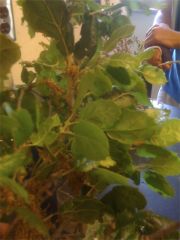
|
Coast Live Oak
Quercus Agrifolia Oak Woodlands |
|

|
California Sage Brush
Artemisia Californica Coastal Scrub |
|
|
Biodiversity Hot Spot
|
Regions that harbor a great diversity of species and have been significantly impacted by humans.
|
|
|
Floristic Provinces
|
Major areas characterized by plants that occur primarily in that region and nowhere else.
|
|
|
3 Floristic Provinces in California
|
1. California Floristic Province
2. Great Basin Floristic Province 3. Sonoran Floristic Province |
|
|
California Floristic Province
|
Includes about 75% of the states area plus the edges of other states.
Contains about 85% of the genera in CA and about 81% of the species. |
|
|
California Biological Diversity
|
CA has about 6000 distinct species.
4844 of these are considered native species (82.6%). 1023 have been introduced (17.4%). |
|
|
SLO county stats
|
3,616 square miles
Population: 250,000 Precipitation: 6-60+ inches Coastline: 100 miles Highest Elevation: 5106 ft (Caliente Peak) 1850 native plant species |
|
|
Native Plants (California)
|
Plants that were present before the visitation or colonization of the state by Europeans.
|
|
|
Endemic Species
|
Confined to a particular location, region, and habitat.
|
|
|
_______ of the species in California are endemic.
_______ of the species in the California Floristic Province are endemics. |
1/3
1/2 |
|
|
Flora
|
A listing of all the plants that occur in an area.
|
|
|
Vegetation
|
The life forms or general aspect of the plants growing in an area (physiognomy), such as shrub land or grassland.
|
|
|
Plant Community
|
A assemblage of different species living in the same area.
|
|
|
Ecotones
|
Spatial borders where two or more communities come together.
|
|
|
Succession
|
Transition of community structure and composition through time.
|
|
|
Function of Leaves
|
Photosynthesis
Regulate Water Loss Storage Protection Attraction Nutrition Propagation Climbing |
|
|
Morphology of a Leaf
|
Blade
Petiole Stipule |
|
|
Blade
|
Expanded portion of the leaf
|
|
|
Petiole
|
Leaf Stalk
|
|
|
Sessile
|
Leaves without a petiole
|
|
|
Stipule
|
Appendage at the base of the petiole
|
|
|
Simple Leaves
|
The leaf blades are not divided into separate parts.
|
|
|
Compound Leaves
|
Leaves are divided into leaflets.
1. Pinnately Compounded 2. Palmately compound |
|
|
Pinnately Compounded
|
Leaflets arise from either side of the rachis.
|
|
|
Palmately Compounded
|
Leaflets diverge from the petiole tip (no rachis, which is an extension of the petiole)
|
|
|
Phyllotaxy
|
The way leaves are arranged along the stem.
|
|
|
Leaf Venation
|
Vein: vascular bundles in the leaves.
|
|
|
Dune Succession
|
1. Sand blows above high tide level.
2. Plants begin to colonize. 3. Plant colony becomes center of a pile know as hummocks. 4. Plants gradually cover dune, and stabilize sands. |
|
|
Foredune Environment
|
Sandy Soil
Unstable Low Fertility Holds Little Water Salt Spray |
|
|
Salt Spray
|
Salt spray coats sand and any exposed plant parts.
|
|
|
Wind Pruning
|
"Wedges" develop with dead plants slanted in front to protect living plants behind it.
|
|
|
Pioneer Dune Plants
|
First plants to colonize, which allows for other plants to follow.
|
|
|
Blowouts
|
A formerly stabilized dune can blow over, burying plants in its path.
May result from a storm action or human activities. |

